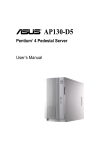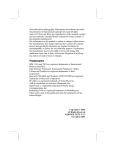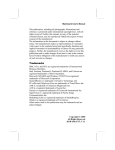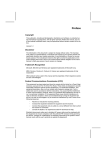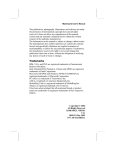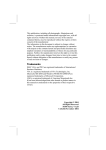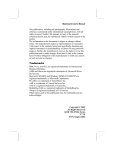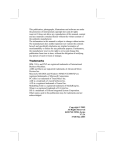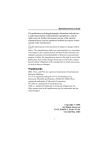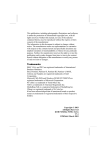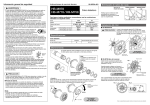Download Trademarks
Transcript
Mainboard User’s Manual This publication, including all photographs, illustrations and software, is protected under international copyright laws, with all rights reserved. Neither this manual, nor any of the material contained herein, may be reproduced without written consent of the author. The information in this document is subject to change without notice. The manufacturer makes no representations or warranties with respect to the contents hereof and specifically disclaims any implied warranties of merchantability or fitness for any particular purpose. Further, the manufacturer reserves the right to revise this publication and to make changes from time to time in the content hereof without obligation of the manufacturer to notify any person of such revision or changes. Trademarks IBM, VGA, and PS/2 are registered trademarks of International Business Machines. Intel, Pentium/II/III, Pentium 4, MMX, Celeron and Tualatin are registered trademarks of Intel Corporation. Microsoft, MS-DOS and Windows 98/ME/NT/2000/XP are registered trademarks of Microsoft Corporation. Sound Blaster is a trademark of Creative Technology Ltd. PC-cillin is a trademark of Trend Micro Inc. AMI is a trademark of American Megatrends Inc. MediaRing Talk is a registered trademark of MediaRing Inc. 3Deep is a registered trademark of E-Color Inc. It has been acknowledged that all mentioned brands or product names are trademarks or registered trademarks of their respective holders. Copyright © 2002 All Rights Reserved M758 Series, V7.0 S63X/August 2002 Mainboard User’s Manual Notice: 1. Please avoid operating “Clear CMOS” and “reFlash BIOS” simultaneously. 2. If users need to proceed the above operations simultaneously, they must reprogram the LAN ID and follow this procedure as bellow: a. You can at least find the LAN ID on the motherboard. b. You can find the programming utility (EE.ZIP) on the Driver CD disc (\LAN\SiS900\Utility\). c. Please follow the “README.TXT” (After unzipping EE.ZIP or under the directory \LAN\SiS900\Utility\) instruction to reprogram your LAN ID. 3. Owing to Microsoft’s certifying schedule is various to every supplier, we might have some drivers not certified yet by Microsoft. Therefore, it might happen under Windows XP that a dialogue box (shown as below) pop out warning you this software has not passed Windows Logo testing to verify its compatibility with Windows XP. Please rest assured that our RD department has already tested and verified these drivers. Just click the “Continue Anyway” button and go ahead the installation. II Mainboard User’s Manual Table of Contents Chapter 1: Introduction....................................................................1 Key Features............................................................................2 Package Contents.....................................................................5 Static Electricity Precautions...................................................6 Pre-Installation Inspection.......................................................6 Chapter 2: Mainboard Installation...................................................7 Mainboard Components ..........................................................8 I/O Ports...................................................................................8 Install A CPU ..........................................................................9 Install Memory ......................................................................12 Setting Jumper Switches........................................................13 Install the Mainboard.............................................................14 Optional Extension Brackets .................................................15 Install Other Devices .............................................................16 Expansion Slots .....................................................................19 Chapter 3: BIOS Setup Utility.......................................................21 Introduction ...........................................................................21 Running the Setup Utility ......................................................22 Standard CMOS Setup Page..................................................23 Advanced Setup Page ............................................................24 Power Management Setup Page ............................................26 PCI / Plug and Play Setup Page.............................................27 Load Optimal Settings ...........................................................28 Load Best Performance Settings............................................28 Features Setup Page...............................................................29 CPU PnP Setup Page .............................................................30 Hardware Monitor Page.........................................................31 Change Password...................................................................32 Exit ........................................................................................32 Chapter 4: Software & Applications .............................................33 Introduction ...........................................................................33 Installing Support Software ...................................................34 Bundled Software Installation………………………………36 III Mainboard User’s Manual IV 1: Introduction Chapter 1 Introduction This mainboard has a Socket-370 processor socket for Intel FCPGA Celeron, FCPGA Pentium III or Tualatin/Tualatin Celeron processors. You can install any one of these processors on this mainboard. This mainboard supports front-side bus speeds of 66MHz, 100MHz or 133MHz. This mainboard has the GFXcel chipset which provides CPU Plug & Play through firmware, integrates a 128-bit AGP Graphics Accelerator and has an embedded 10BaseT/100BaseTX Network Interface. There is a full set of ATX I/O Ports including PS/2 keyboard and mouse ports, two USB ports, one parallel port, one serial port, one VGA port and one MIDI/game port. There is an onboard header USB1 making two extra USB ports by connecting the extended USB module to the mainboard. This mainboard has all the features you need to develop a powerful multimedia workstation of network ready and built-in communications. This board is Micro-ATX size and has power connector for an ATX power supply. 1 Mainboard User’s Manual Key Features The key features of this mainboard include: Socket-370 Processor Support ♦ Supports FCPGA Celeron, FCPGA Pentium III and Tualatin/Tualatin Celeron CPUs ♦ Supports 66MHz, 100MHz or 133MHz Front-Side Bus All processors are automatically configured using firmware and a synchronous/asynchronous Host/DRAM Clock Scheme. Note: 1. The Socket-370 on this mainboard doesn’t support PPGA Celeron CPU. 2. Please refer to Page 9 and 10 for more detailed description about Tualatin/Tualatin Celeron CPU. Memory Support ♦ Two DIMM slots for 168-pin SDRAM memory modules ♦ Support for 66MHz, 100MHz, & 133MHz memory bus ♦ Maximum installed memory is 2 x 512MB = 1 GB Expansion Slots ♦ Three 32-bit PCI slots Onboard IDE channels ♦ Primary and Secondary PCI IDE channels ♦ Support for PIO (programmable input/output) modes ♦ Support for Multiword DMA modes ♦ Support for Bus Mastering and Ultra DMA 33/66/100 modes (the Ultra DMA 100 mode is optional, please refer to Page 9,10) Power Supply and Power Management ♦ ATX power supply connector ♦ ACPI and previous PMU support, suspend switch, keyboard power on/off ♦ Supports Wake on Modem, Wake on LAN and Wake on Alarm 2 1: Introduction Built-in Graphics System ♦ Onboard 128-bit 2D/3D 100MHz Host interface AGP Graphics Accelerator Complies with AGP V2.0 ♦ Shared memory architecture allows a maximum of 64 MB main memory to act as frame buffer ♦ Supports high resolutions up to 1920x1200 16M colors, up to 2048x2048 Texture size and Virtual screen up to 4096x4096 ♦ Supports hardware DVD Accelerator AC97 Audio Codec: CMI9738 ♦ Compliant with AC’97 2.2 specification ♦ Full-duplex Codec with independent and variable sampling rate ♦ Earphone Buffer Built-In, SNR up to 90db ♦ 4Ch DAC, support 4-channel speak-out ♦ Advanced power management support Onboard I/O Ports ♦ Provides PC99 Color Connectors for easy peripheral device connections ♦ Floppy disk drive connector with 1Mb/s transfer rate ♦ One serial port with 16550-compatible fast UART ♦ One parallel port with ECP and EPP support ♦ Four USB ports (two for optional) and two PS/2 ports for keyboard and mouse ♦ One infrared port connector for optional module Built-in Ethernet LAN ♦ 10BaseT/100BaseTX Ethernet LAN ♦ LAN controller integrates Fast Ethernet MAC and PHY compliant with IEEE802.3u 100BASE-TX, 10BASE-T and ANSI X3.263 TP-PMD standards ♦ Compliant with ACPI 1.0 and the Network Device Class Power Management 1.0 ♦ High Performance provided by 100Mbps clock generator and data recovery circuit for 100Mbps receiver 3 Mainboard User’s Manual Onboard Flash ROM ♦ Automatic CPU and board configuration ♦ Supports Plug and Play configuration of peripheral devices and expansion cards Bundled Software ♦ PC-Cillin2000 provides automatic virus protection under Windows 98/ME/NT/2000/XP ♦ MediaRing Talk provides PC to PC or PC to Phone internet phone communication ♦ 3Deep delivers the precise imagery and displays accurate color in your monitor ♦ Recovery Genius 21st V5.0 provides the function to recover, reserve and transfer hard disk data. ♦ CD Ghost is the software stimulating a real CD-ROM to perform equivalent function. ♦ Language Genius 21st is the software to provide learning tools of language and singing. ♦ PC DJ is a dual-MP3 player that enables users to actually mix music right on their own personal computers. ♦ Adobe Acrobat Reader V5.0 is the software to help users read .PDF files. Dimensions ♦ Micro-ATX form factor (24.4cm x 19cm) 4 1: Introduction Package Contents Attention: This mainboard series have four different models, M758L (LAN), M758LT(LAN, support Tualatin CPU), M758T(support Tualatin CPU), and M758 (without LAN). Please contact your local supplier for your purchased model. Each model will support different specification listed as below: Model Specification M758L Onboard LAN (RJ45) connector M758LT Onboard LAN (RJ45) connector, support Tualatin CPU M758T Support Tualatin CPU M758 --Your mainboard package ships with the following items: The mainboard This User’s Guide 1 UDMA/66 IDE cable Floppy disk drive cable Support software on CD-ROM disk Optional Accessories You can purchase the following optional accessories for this mainboard. Extended USB module 5 Mainboard User’s Manual Static Electricity Precautions Static electricity could damage components on this mainboard. Take the following precautions while unpacking this mainboard and installing it in a system. 1. Don’t take this mainboard and components out of their original static-proof package until you are ready to install them. 2. While installing, please wear a grounded wrist strap if possible. If you don’t have a wrist strap, discharge static electricity by touching the bare metal of the system chassis. 3. Carefully hold this mainboard by its edges. Do not touch those components unless it is absolutely necessary. Put this mainboard on the top of static-protection package with component side facing up while installing. Pre-Installation Inspection 1. Inspect this mainboard whether there are any damages to components and connectors on the board. 2. If you suspect this mainboard has been damaged, do not connect power to the system. Contact your mainboard vendor about those damages. 6 2: Mainboard Installation Chapter 2 Mainboard Installation To install this mainboard in a system, please follow these instructions in this chapter: Identify the mainboard components Install a CPU Install one or more system memory modules Make sure all jumpers and switches are set correctly Install this mainboard in a system chassis (case) Connect any extension brackets or cables to connecting headers on the mainboard Install other devices and make the appropriate connections to the mainboard connecting headers. Note: 1. Before installing this mainboard, make sure the jumper JP7 is set to Normal setting. See this chapter for information about locating jumper JP7 and the setting options. 2. Never connect power to the system while installing; otherwise, it may damage the mainboard. 7 Mainboard User’s Manual Mainboard Components This diagram helps you identify major components on this mainboard. Note: Any jumpers on your mainboard that do not appear in this illustration are for testing only. I/O Ports This illustration shown below is a side view of the built-in I/O ports on this mainboard. PS/2 Mouse LAN Port Parallel Port VGA Port PS/2 Keyboard USB Ports 8 Line-Out Jack Serial Port COM1/3 Game/MIDI Port Microphone Jack Line-In Jack 2: Mainboard Installation I/O Pannel Before installing this mainboard, it is necessary to remove the original I/O panel and install our I/O panel to the system case as follows. I/O panel A back view of the system case Install A CPU This mainboard has a Socket 370 supporting FCPGA Celeron, FCPGA Pentium III and Tualatin/Tualatin Celeron processors. Do not support PPGA Celeron processor. To ensure reliability, ensure that your processor has a heatsink/cooling fan assembly. Do not try to install a Socket 7 processor in the Socket-370. A Socket 7 processor such as the Pentium-MMX, or the AMD K5/K6 does not fit in the Socket 370. Do not try to install PPGA Celeron processor in Socket-370. The following list notes the processors that are currently supported by this mainboard. FCPGA Celeron: 300~966 MHz, FSB: 66 MHz FCPGA Pentium III: 500~1130MHz, FSB: 100MHz, 133MHz Tualatin/Tualatin Celeron: up to 1.4GHz, FSB: 100MHz(only for model M758LT and M758T) 9 Mainboard User’s Manual The “T” in the model name indicates this mainboard supporting Tualatin CPU. You can also tell the difference by one RED IDE connector and two “T” labels beside the socket. Two “T” labels beside the socket indicate Tualatin 10 One RED IDE connector 2: Mainboard Installation Installing a Socket-370 Processor Install a processor into the ZIF (Zero Insertion Force) Socket-370 on the mainboard. 1. Locate the Socket-370 and FAN1. Pull the locking lever out slightly from the socket and raise it to the upright position. FAN1 Pin-1 Corner Socket-370 2. Identify the Pin-1 corner of the processor by its beveled edge. 3. Identify the Pin-1 corner on the Socket-370. The Pin-1 corner is at the top of the locking lever when it is locked. 4. Insert the processor into the socket matching the Pin-1 corner. The processor should drop into place freely without force. 5. Push locking lever down and hook it under the catch on the side of socket. This secures the CPU in the socket. 6. All processors should be installed together with a heatsink /cooling fan, connecting the cable from the fan to the CPU fan power connector FAN1. 11 Mainboard User’s Manual Install Memory This mainboard has two DIMM sockets for system memory modules. You must install at least one memory module in order to work out this mainboard. You must install the first memory module in the DIMM1 socket to give shared memory to the onboard VGA display circuitry. DIMM1 DIMM2 For this mainboard, you must use 168-pin, 3.3V unbuffered SDRAM memory modules. If the installed CPU uses a 100MHz system bus, you must use PC100 or PC133 memory; if a 66MHz system bus, you must use PC66 memory. You can install any size memory module from 16 MB to 512MB, so the maximum memory size is 2 x 512MB = 1GB. Edge connectors on the memory modules have cut outs coinciding with spacers in the DIMM sockets that memory modules can only be installed in the correct orientation. To install a module, push the retaining latches at either end of the socket outwards. Position the memory module correctly and insert it into the DIMM socket. Press the module down into the socket so that the retaining latches rotate up and secure the module in place by fitting into notches on the edge of the module. 12 2: Mainboard Installation Setting Jumper Switches Jumpers are sets of pins connected together with caps. Jumper caps change the way of mainboard’s operation by changing the electronic circuits on the mainboard. If a jumper cap connects two pins, we say those pins are SHORT; if the cap is removed, they are OPEN. JP7 1 Jumper JP7: Clear CMOS Memory This jumper can clear the contents of the CMOS memory. You may need to clear the CMOS memory if the settings in the Setup Utility are incorrect and prevent your mainboard from operating. To clear the CMOS memory, disconnect all the power cables from the mainboard and then move the jumper cap into the CLEAR setting for a few seconds. Function Normal Operation Clear CMOS Memory Jumper Setting Short Pins 1-2 Short Pins 2-3 13 Mainboard User’s Manual Install the Mainboard Install this mainboard in a system chassis (case). This board is a Micro-ATX size mainboard with a twin-tier of I/O ports. You can install this mainboard in any ATX case. Make sure your case has an I/O cover plate that matches the ports on this mainboard. Install this mainboard in a case. Follow these instructions of the case manufacturer to use the hardware and internal mounting points on the chassis. 1 CHS FAN AUDIO2 PWR1 1 SW1 1 SPKR1 Connect the power connector from the power supply to the PWR1 ATX Power connector on the mainboard. If there is a cooling fan installed in the system chassis, connect the cable from the cooling fan to the CHS FAN fan power connector on the mainboard. Connect the cable from the PC speaker to the SPKR1 header on the mainboard. Pin 1 3 Signal SPKR GND Pin 2 4 Signal NC +5V Connect the case switches and indicator LEDs to the SW1 header. Here is the list of SW1 pin assignment. Pin 1 3 5 7 9 14 Signal HDD LED HDD LED RESET SWITCH RESET SWITCH RSVD_DNU Pin 2 4 6 8 10 Signal POWER(ACPI) LED POWER(ACPI) LED POWER BUTTON POWER BUTTON KEY 2: Mainboard Installation If there are a headphone jack or/and a microphone jack on the front panel, connect the cables to the AUDIO2 header on the mainboard. Here is the list of AUDIO2 pin assignment. Pin 1 3 5 7 9 Signal MIC MIC-P FPOUT-R NC FPOUT-L Pin 2 4 6 8 10 Signal GND VCC RET-R KEY RET-L Optional Extension Brackets You also have a USB module extension bracket for this mainboard. Install it by following these steps below. Extended USB Module This module bracket has two USB ports for more USB devices. USB1 Header 1 Pin 1 3 5 7 9 Signal VERG_FP_USBPWR0 USB_FP_P0USB_FP_P0+ GROUND KEY Pin 2 4 6 8 10 Signal VERG_FP_USBPWR0 USB_FP_P1USB_FP_P1+ GROUND USB_FP_OC0 1. Locate the USB1 header on this mainboard. 2. Plug the bracket cable onto the header. 3. In the system chassis, remove a slot cover from one of the expansion slots and install the extension bracket into that emptied slot. Secure this extension bracket to the chassis with a screw. 15 Mainboard User’s Manual Install Other Devices Follow these steps below to install and connect other devices in the system. IDE2 1 FLOPPY 1 IDE1 1 Floppy Disk Drive The mainboard ships with a floppy disk drive cable that can support one or two drives. Drives can be 3.5” or 5.25” wide, with capacities of 360K, 720K, 1.2MB, 1.44MB, or 2.88MB. Install your drives and connect power from the system power supply. Use the enclosed cable to connect the drives to the floppy disk drive header FLOPPY. IDE Devices IDE devices include hard disk drives, high-density diskette drives, and CD-ROM or DVD-ROM drives, among others. The mainboard ships with an IDE cable that can support one or two IDE devices. If you connect two devices to one single cable, you must configure one of the drives as Master and the other as Slave. The documentation of the IDE device will tell you how to configure the device as a Master or Slave device. The Master device connects to the end of the cable. 16 2: Mainboard Installation Install the device(s) and connect power from the system power supply. Use the enclosed cable to connect the device(s) to the Primary IDE channel connector IDE1 on the mainboard. If you want to install more IDE devices, you can purchase a second IDE cable and connect one or two devices to the Secondary IDE channel connector IDE2 on the mainboard. If you have two devices on the cable, one must be Master and another must be Slave. Internal Sound Connections If you have installed a CD-ROM drive or DVD-ROM drive, you can connect the drive audio cable to the onboard sound system. On the mainboard, locate the two 4-pin connectors CD1 and CD2. There are two kinds of connectors because different brands of CDROM drive have different audio cable connectors. Connect the cable to the appropriate connector. CD1 1 CD2 CD1 Pin 1 2 3 4 Signal GND CD IN R GND CD IN L CD2 Pin 1 2 3 4 Signal CD IN L GND GND CD IN R 17 Mainboard User’s Manual Infrared Port You can connect an infrared port to the mainboard. You can purchase this option from third-party vendors. 1 IR1 Header Pin 1 3 5 Signal NC +5V IRTX Pin 2 4 6 Signal KEY GND IRRX 1. Locate the infrared port IR1 header on the mainboard. 2. If you are adding an infrared port, connect the ribbon cable from the port to the header and then secure the port to an appropriate place in your system chassis. 18 2: Mainboard Installation Expansion Slots This mainboard has three 32-bit PCI expansion slots. PCI1/2/3 J8-WOL connector Follow these steps below to install a PCI expansion card. 1. Locate the PCI slots on the mainboard. 2. Remove the expansion slot cover from the system chassis. 3. Insert the expansion card edge connector into the slot and press it firmly down into until fully inserted. 4. Secure the expansion card bracket to the system chassis with a screw. Wake On LAN (WOL) If you are using an ATX power supply you can configure your system so that it powers down by software and can be resumed by alarms. If you have installed a LAN adapter expansion card, connect the card to the Wake On LAN connector J8. This allows incoming traffic to resume the system from a software power down. You need to enable this feature in the system setup utility. 19 Mainboard User’s Manual 20 3: BIOS Setup Utility Chapter 3 BIOS Setup Utility Introduction The BIOS Setup Utility records settings and information of your computer, such as date and time, the type of hardware installed, and various configuration settings. Your computer applies those information to initialize all the components when booting up and basic functions of coordination between system components. If the Setup Utility configuration is incorrect, it may cause the system to malfunction. It can even stop your computer booting properly. If it happens, you can use the clear CMOS jumper to clear the CMOS memory which has stored the configuration information; or you can hold down the Page Up key while rebooting your computer. Holding down the Page Up key also clears the setup information. You can run the setup utility and manually change the configuration. You might need to do this to configure some hardware installed in or connected to the mainboard, such as the CPU, system memory, disk drives, etc. 21 Mainboard User’s Manual Running the Setup Utility Every time you start your computer, a message appears on the screen before the operating system loading that prompts you to “Hit <DEL>if you want to run SETUP”. Whenever you see this message, press the Delete key, and the Main menu page of the Setup Utility appears on your monitor. AMIBIOS SIMPLE SETUP UTILITY – VERSION 1.21.06 (C) 2000 American Megatrends, Inc. All Rights Reserved Standard CMOS Setup Features Setup Advanced Setup CPU PnP Setup Power Management Setup Hardware Monitor PCI / Plug and Play Setup Change Password Load Optimal Settings Exit Load Best Performance Settings Esc : Quit ↑ ↓ ← →: Select Item (Shift)F2 : Change Color F5 : Old Values F6 : Optimal values F7 : Best performance values F10 : Save&Exit Standards COMOS setup for changing time, date, hard disk type, etc. You can use cursor arrow keys to highlight anyone of options on the main menu page. Press Enter to select the highlighted option. Press the Escape key to leave the setup utility. Hold down the Shift key and press F2 to cycle through the Setup Utility’s optional color schemes. Some options on the main menu page lead to tables of items with installed values that you can use cursor arrow keys to highlight one item, and press PgUp and PgDn keys to cycle through alternative values of that item. The other options on the main menu page lead to dialog boxes that require your answer Yes or No by hitting the Y or N keys. If you have already changed the setup utility, press F10 to save those changes and exit the utility. Press F5 to reset the changes to the original values. Press F6 to install the setup utility with a set of default values. Press F7 to install the setup utility with a set of high-performance values. 22 3: BIOS Setup Utility Standard CMOS Setup Page Use this page to set basic information such as the date and time, the IDE devices, and the diskette drives. If you press the F3 key, the system will automatically detect and configure the hard disks on the IDE channels. AMIBIOS SETUP – STANDARD CMOS SETUP (C) 2000 American Megatrends, Inc. All Rights Reserved Date (mm/dd/yy) : Thu Aug 22, 2002 Time (hh/mm/ss) : 15:34:09 LBA Blk PIO 32Bit Type Size Cyln Head WPcom Sec Mode Mode Mode Mode Pri Master : Not Installed Pri Slave : Not Installed Sec Master : Not Installed Sec Slave : Not Installed Floppy Drive A : Not Installed Floppy Drive B : Not Installed Month : Jan – Dec Day : 01 – 31 Year : 1901 – 2099 Date & Time Pri Master Pri Slave Sec Master Sec Slave Floppy Drive A Floppy Drive B ESC : Exit ↑↓ : Select Item PU/PD/+/- : Modify (Shift)F2 : Color F3 : Detect All HDD Use these items to set the system date and time Use these items to configure devices connected to the Primary and Secondary IDE channels. To configure an IDE hard disk drive, choose Auto. If the Auto setting fails to find a hard disk drive, set it to User, and then fill in the hard disk characteristics (Size, Cyls, etc.) manually. If you have a CD-ROM drive, select the setting CDROM. If you have an ATAPI device with removable media (e.g. a ZIP drive or an LS-120) select Floptical. Use these items to set the size and capacity of the floppy diskette drive(s) installed in the system. 23 Mainboard User’s Manual Advanced Setup Page This page sets up more advanced information about your system. Be careful to set up this page, for any changes can affect the operation of your computer. AMIBIOS SETUP – ADVANCED SETUP (C) 2000 American Megatrends, Inc. All Rights Reserved Share Memory Size 1st Boot Device 2nd Boot Device 3rd Boot Device Try Other Boot Devices S.M.A.R.T. for Hard Disks BootUp Num-Lock Floppy Drive Swap Floppy Drive Seek PS/2 Mouse Support Password Check Boot To OS/2 > 64MB Internal Cache System BIOS Cacheable Spread Sectrum CAS Latency 16 MB IDE-0 Floppy CDROM Yes Disabled On Disabled Disabled Enabled Setup No Enabled Disabled Disabled 3T ESC : Quit ↑↓←→ : Select Item F1 : Help PU/PD/+/- : Modify F5 : Old Values (Shift)F2 : Color F6 : Load BIOS Defaults F7 : Load Setup Defaults Share Memory Size 1st Boot Device 2nd Boot Device 3rd Boot Device Try Other Boot Device This item lets you allocate a portion of the main memory for use by the onboard VGA display. S.M.A.R.T. for Hard Disks Enable this item if any IDE hard disks support the S.M.A.R.T. (Self-Monitoring, Analysis and Reporting Technology) feature. BootUp NumLock This items determines if the Num Lock key is active or inactive at system start-up time. 24 Use these items to determine the device order the computer uses to look for an operating system to load at start-up time. If you enable this item, the system will also search for other boot devices if it fails to find an operating system from the first two locations. 3: BIOS Setup Utility Floppy Drive Swap If you have two diskette drives installed and you enable this item, drive A becomes drive B and drive B becomes drive A. Floppy Drive Seek If you enable this item, your system will check all floppy disk drives at start up. Disable this item unless you are using an old 360KB drive. PS/2 Mouse Support If this item is set to Enabled, the onboard PS/2 Mouse port will work. Setting this to Disable turns off the port. Password Check If you have entered a password for the system, use this item to determine if the password is required to enter the Setup Utility (Setup) or required both at start-up and to enter the Setup Utility (Always). Boot to OS/2 > 64MB Enable this item if you are booting the OS/2 operating system and you have more than 64MB of system memory installed. Internal Cache Leave this item enabled since all the processors that can be installed on this board have internal cache memory. System BIOS Cacheable If you enable this item, a segment of the system BIOS will be cached to main memory for faster execution. Spread Spectrum If you enable spread spectrum, it can significantly reduce the EMI(Electro-Magnetic Interference) generated by the system. CAS Latency This item determines the operation of the SDRAM memory CAS (column address strobe). We recommend that you leave this item at the default value. The 2T setting requires faster memory that specifically supports this mode. 25 Mainboard User’s Manual Power Management Setup Page This page sets up some parameters for system power management operation. AMIBIOS SETUP – POWER MANAGEMENT SETUP (C) 2000 American Megatrends, Inc. All Rights Reserved Power Management/APM Standby Time Out(Minute) Suspend Time Out(Minute) Hot Key Power On OnBoard LAN Power On Ring On Power On RTC Alarm Power On RTC Alarm Date RTC Alarm Hour RTC Alarm Minute RTC Alarm Second APM/ACPI Disabled Disabled Disabled Disabled Disabled Disabled 15 12 30 30 ESC : Quit ↑↓←→ : Select Item F1 : Help PU/PD/+/- : Modify F5 : Old Values (Shift)F2 : Color F6 : Load BIOS Defaults F7 : Load Setup Defaults Power Management/APM Use this item to enable or disable a power management scheme. If you enable power management, you can use the items below to set the power management operation. Both APM and ACPI are supported. Standby Time Out (Minute) This sets the timeout for Standby mode in minutes. If the time selected passes without any system activity, the computer will enter powersaving Standby mode. Suspend Time Out (Minute) This sets the timeout for Suspend mode in minutes. If the time selected passes without any system activity, the computer will enter powersaving Suspend mode. Hot Key Power On If you enable this item, you can turn the system on by pressing hot keys (Ctrl+Alt+BackSpace) on the keyboard. You must connect an ATX power supply and enable the jumper in order to use this feature. OnBoard Lan Power On The system can be turned off with a software command. If you enable this item, the system can automatically resume if there is traffic on the network adapter. You must use an ATX power supply in order to use this feature. 26 3: BIOS Setup Utility Ring On Power On The system can be turned off with a software command. If you enable this item, the system can automatically resume if there is an incoming call on the Fax/Modem. You must use an ATX power supply in order to use this feature. RTC Alarm Power On The system can be turned off with a software command. If you enable this item, the system can automatically resume at a fixed time based on the system’s RTC (realtime clock). Use the items below this one to set the date and time of the wake-up alarm. You must use an ATX power supply in order to use this feature. PCI / Plug and Play Setup Page This page sets up some parameters for those devices installed on the PCI bus and utilizing the system plug and play capability. AMIBIOS SETUP – PCI / PLUG AND PLAY SETUP (C) 2000 American Megatrends, Inc. All Rights Reserved Plug and Play Aware O/S Primary Graphics Adapter Allocate IRQ for PCI VGA Reserved Memory Size Reserved Memory Address Yes PCI Yes Disabled C8000 ESC : Quit ↑↓←→ : Select Item F1 : Help PU/PD/+/- : Modify F5 : Old Values (Shift)F2 : Color F6 : Load BIOS Defaults F7 : Load Setup Defaults Plug and Play Aware O/S Enable this item if you are using an O/S that supports Plug and Play such as Windows 95 or 98. Primary Graphics Adapter This item indicates if the primary graphics adapter uses the PCI or AGP bus. The default PCI setting still lets the onboard display work and allows the use of a second display card installed in a PCI slot. Allocate IRQ to PCI VGA If this item is enabled, an IRQ will be assigned to the PCI VGA graphics system. You set this value to No to free up an IRQ. 27 Mainboard User’s Manual Reserved Memory Size Reserved Memory Address This item lets you reserve a block of memory for any device that requires it. This item lets you set the address for any block of memory that has been reserved. Load Optimal Settings If you select this item and press Enter a dialog box appears. If you press Y, and then Enter, the Setup Utility loads a set of fail-safe default values. These default values are not very demanding and they should allow your system to function with most kinds of hardware and memory chips. Note: It is highly recommended that users enter this option to load optimal values for accessing the best performance. Load Best Performance Settings If you select this item and press Enter a dialog box appears. If you press Y, and then Enter, the Setup Utility loads a set of bestperformance default values. These default are quite demanding and your system might not function properly if you are using slower memory chips or other low-performance components. 28 3: BIOS Setup Utility Features Setup Page This page sets up some parameters for peripheral devices connected to the system. AMIBIOS SETUP – FEATURES SETUP (C) 2000 American Megatrends, Inc. All Rights Reserved OnBoard FDC OnBoard Serial PortA OnBoard IR Port OnBoard Parallel Port Parallel Port Mode Parallel Port IRQ Parallel Port DMA OnBoard PCI IDE Ultra DMA Support On Chip Audio On Chip Modem OnBoard LAN USB Function USB Function For DOS Enabled 3F8h/COM1 Disabled 378h EPP+ECP 7 3 Both Disabled Enabled Enabled Enabled Enabled Disabled ESC : Quit Item ↑↓←→ : Select F1 : Help PU/PD/+/- : Modify F5 : Old Values (Shift)F2 : Color F6 : Load BIOS Defaults F7 : Load Setup Defaults OnBoard FDC Use this item to enable or disable the onboard floppy disk drive interface. OnBoard Serial PortA OnBoard IR Port Use this item to enable or disable the onboard COM1 serial port, and to assign a port address Onboard Parallel Port Use this item to enable or disable the onboard LPT1 parallel port, and to assign a port address. The Auto setting will detect and available address. Parallel Port Mode Use this item to set the parallel port mode. You can select SPP (Standard Parallel Port), ECP (Extended Capabilities Port), EPP (Enhanced Parallel Port), or ECP + EPP. Parallel Port IRQ Use this item to assign either IRQ 5 or 7 to the parallel port. Parallel Port DMA Use this item to assign a DMA channel to the parallel port. The options are 0, 1 and 3. Use this item to define the protocol for an infrared port if you have installed an optional IR port. The choices are IrDA and ASKIR. 29 Mainboard User’s Manual Onboard PCI IDE Use this item to enable or disable either or both of the onboard Primary and Secondary IDE channels. Ultra DMA Support Use this item to set Ultra DMA support for IDE devices on the Primary or Secondary IDE channels. You must enable this or UDMA devices will not work at their intended speed. On Chip Audio/Modem OnBoard LAN This item enables or disables the onboard audio/modem chip. USB Function Enable this item if you plan to use the USB ports on this mainboard. USB Function for DOS Enable this item if you plan to use the USB ports on this mainboard in a DOS environment. This item enables or disables the onboard network interface. CPU PnP Setup Page This page helps you manually configure the CPU of this mainboard. The system will automatically detect the type of installed CPU and make appropriate adjustments to all items on this page. Note: If you manually set up wrong speed that the system doesn’t run properly, press the Page Up key while the system is booting and a default setting will replace the incorrect CPU setting. AMIBIOS SETUP – CPU PnP SETUP ©2000 American Megatrends, Inc. All Rights Reserved CPU Speed CPU/DRAM Freq. CPU Multiplier Freq. 850 MHz 100/100 MHz X8.5 ESC F1 F5 F6 F7 30 : : : : : Quit ↑↓←→ : Select Item Help PU/PD/+/- : Modify Old Values (Shift)F2 : Color Load Optimal values Load Best performance values 3: BIOS Setup Utility CPU Speed The item displays the internal clock speed of the CPU, based on the next two items. CPU/DRAM Frequency Use this item to sets the external clock frequency for the CPU and the memory bus frequency. The options include combinations of 66 and 100MHz. Set the CPU clock based on the requirements of the CPU installed on the board. Select the memory frequency based on the speed of the memory installed on the board. CPU Multiplier Frequency Use this item to set a multiplier for the CPU external frequency. The multiplier times the external CPU frequency sets the internal clock speed of the CPU, e.g. 100 MHz (external clock or “FSB”) x 4.5 (muliplier) = 450 MHz (internal clock speed of the installed CPU). Hardware Monitor Page This page sets up some parameters for the hardware monitoring function of this mainboard. AMIBIOS SETUP – HARDWARE MONITOR (C) 2000 American Megatrends, Inc. All Rights Reserved *** Hardware Monitor *** CPU Temperature SYSTEM Temperature Fan#1 Speed Fan#2 Speed Vcore +1.800V Vcc3 Vcc +12V SB5V 51°C/123°F 39°C/102°F 5273 RPM 0 RPM 1.632 V 1.824 V 3.296 V 4.972 V 11.968 V 5.026 V ESC : Quit ↑↓←→ : Select Item F1 : Help PU/PD/+/- : Modify F5 : Old Values (Shift)F2 : Color F6 : Load BIOS Defaults F7 : Load Setup Defaults CPU, System Temperature These items display CPU and the system temperature measurement. The system will alert you if a safe temperature is exceeded. FAN#1, 2 Speed & Voltage Measurements These items indicate cooling fan speeds in RPM and the various system voltage measurements. If the values deviate beyond certain limits, the hardware monitoring feature will alert you with a warning. 31 Mainboard User’s Manual Change Password If you highlight this item and press Enter, a dialog box appears which lets you enter a Supervisor password. You can enter no more than six letters or numbers. Press Enter after you have typed in the password. A second dialog box asks you to retype the password for confirmation. Press Enter after you have retyped it correctly. The password is then required to access the Setup Utility or for that and at start-up, depending on the setting of the Password Check item in Advanced Setup. Change or Remove the Password Highlight this item, press Enter and type in the current password. At the next dialog box, type in the new password, or just press Enter to disable password protection. Exit Highlight this item and press Enter to save the changes that you have made in the Setup Utility configuration and exit the program. When the Save and Exit dialog box appears, press Y to save and exit, or press N to exit without saving. 32 4: Software & Applications Chapter 4 Software & Applications Introduction This chapter describes the contents of the support CD-ROM that comes with the mainboard package. The support CD-ROM contains all useful software, necessary drivers and utility programs to properly run our products. More program information is available in a README file, located in the same directory as the software. To run the support CD, simply insert the CD into your CD-ROM drive. An Auto Setup screen automatically pops out, and then you can go on the auto-installing or manual installation depending on your operating system. If your operating system is Windows 98/ME/2000/XP, it will automatically install all the drivers and utilities for your mainboard; if Windows NT or manual installation, please follow the instructions described as the Installing under Windows NT or Manual Installation section. 33 Mainboard User’s Manual Installing Support Software 1.Insert the support CD-ROM disc in the CD-ROM drive. 2.When you insert the CD-ROM disc in the system CD-ROM drive, the CD automatically displays an Auto Setup screen. 3.The screen displays three buttons of Setup, Browse CD and Exit on the right side, and three others Setup, Application and ReadMe at the bottom. Please see the following illustration. The Setup button runs the software auto-installing program as explained in next section. The Browse CD button is a standard Windows command that you can check the contents of the disc with the Windows 98 file browsing interface. The Exit button closes the Auto Setup window. To run the program again, reinsert the CD-ROM disc in the drive; or click the CD-ROM driver from the Windows Explorer, and click the Setup icon. The Application button brings up a software menu. It shows the bundled software that this mainboard supports. The ReadMe brings you to the Install Path where you can find out path names of software driver. 34 4: Software & Applications Auto-Installing under Windows 98/ME/2000/XP If you are under Windows 98/ME/2000/XP, please click the Setup button to run the software auto-installing program while the Auto Setup screen pops out after inserting the support CD-ROM: 1. The installation program loads and displays the following screen. Click the Next button. 2. Select the items that you want to setup by clicking on it (the default options are recommended). Click the Next button to proceed. 3. The support software will automatically install. Once any of the installation procedures start, software is automatically installed in sequence. You need to follow the onscreen instructions, confirm commands and allow the computer to restart as few times as needed to complete installing whatever software you selected. When the process is finished, all the support software will be installed and start working. 35 Mainboard User’s Manual Installing under Windows NT or Manual Installation If you are under Windows NT, the auto-installing program doesn’t work out; or you have to do the manual installation, please follow this procedure while the Auto Setup screen pops out after inserting the support CD-ROM: 1. Click the ReadMe to bring up a screen, and then click the Install Path at the bottom of the screen. 2. Find out your mainboard model name and click on it to obtain its correct driver directory. 3. Install each software in accordance with the corresponding driver path. Bundled Software Installation All bundled software available on the CD-ROM is for users’ convenience. You can install bundled software as follows: 1. Click the Application button while the Auto Setup screen pops out after inserting the support CD-ROM. 2. A software menu appears. Click the software you want to install. 3. Follow onscreen instructions to install the software program step by step until finished. 36








































